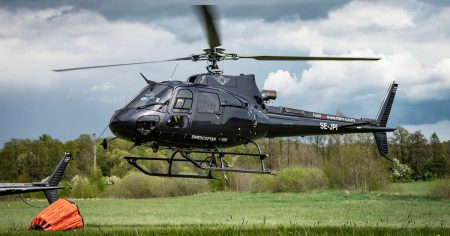A bus became stranded on a railway crossing in Nordanstig Municipality, Sweden, shortly before 6:00 am. Due to icy road conditions, the bus driver lost control and the vehicle became stuck on the tracks. Upon seeing an approaching train, the driver evacuated the bus before the collision. The train, unable to brake in time, impacted the bus, resulting in significant damage to the vehicle. Fortunately, there were no passengers on board the bus, and the train driver remained unharmed. However, the impact of the collision caused the train’s locomotive to derail, although the passenger cars remained on the tracks.
Emergency services arrived at the scene around 7:30 am. They faced a complex recovery operation due to the locomotive’s derailment and the substantial damage to both the train and the bus. The impacted train line sustained considerable damage, leading to significant disruptions in rail traffic. Authorities estimated the restoration work would continue until at least 4:00 pm, affecting numerous train services.
The Swedish Transport Administration reported significant damage to the railway infrastructure. Several SJ (Swedish State Railways) trains operating on routes between major cities like Stockholm, Umeå, Luleå, Sundsvall, Narvik, Östersund, and Duved were either delayed or cancelled due to the incident. SJ implemented contingency plans, including turning back some trains and providing bus replacements for affected sections of the route. Some trains were also rerouted through Ljusdal to bypass the accident site.
The police seized the bus for investigation, although no criminal suspicions were raised against either the bus driver or the train driver. The incident highlighted the potential dangers associated with adverse weather conditions, especially at railway crossings. The quick thinking of the bus driver in evacuating the vehicle prior to the collision likely prevented any injuries or fatalities. The incident also underscored the challenges involved in recovering derailed trains and repairing damaged railway infrastructure.
This incident serves as a reminder of the vulnerability of level crossings, especially during inclement weather. The bus driver’s swift action in exiting the bus averted a potentially tragic outcome. The subsequent disruption to rail services demonstrates the cascading effects of such incidents on the wider transportation network. The significant damage to the railway infrastructure further complicates the recovery process, requiring extensive repairs and replacement of damaged components. The economic impact of the delays and cancellations is likely to be substantial, affecting both passenger travel and freight transport.
The incident highlights the need for ongoing safety reviews and improvements at level crossings, particularly those in areas prone to icy conditions. Possible preventative measures could include enhanced warning systems, improved signage, and increased driver education on navigating these crossings during adverse weather. The incident also emphasizes the importance of robust emergency response plans and the need for efficient recovery procedures to minimize disruption to rail services. Further investigation into the incident may provide valuable insights into how to prevent similar occurrences in the future and improve the overall safety of level crossings. The investigation could also explore the effectiveness of current safety measures and identify areas for improvement.
This particular incident occurred against the backdrop of broader concerns about declining punctuality in Swedish rail services. Reports indicate that train punctuality has reached its lowest point since 2010, highlighting the ongoing challenges facing the Swedish rail network. Planned maintenance and upgrades on major lines, such as the Stockholm-Gothenburg route, will necessitate extended closures over the next four years, potentially exacerbating existing delays and disruptions. This incident further underscores the need for continued investment in rail infrastructure to improve reliability and resilience in the face of both unforeseen events and planned maintenance work.
The long-term solution to preventing similar incidents necessitates a multi-pronged approach involving infrastructure improvements, enhanced safety protocols, and improved communication between transportation authorities and the public. This could include upgrading level crossings to incorporate automated barriers and warning systems, improving driver training programs to emphasize the importance of caution at railway crossings, and implementing more effective strategies for managing rail traffic during adverse weather conditions. The investigation into this specific incident will hopefully shed light on the root causes and contribute to the development of more effective preventative measures to ensure the safety and reliability of the Swedish rail network.
The economic ramifications of this incident extend beyond the immediate costs of repairing the damaged infrastructure and recovering the derailed train. The disruptions to passenger and freight services have a ripple effect, impacting businesses, commuters, and the overall economy. Delays and cancellations can result in lost productivity, missed appointments, and increased transportation costs. This underscores the importance of investing in robust and resilient transportation infrastructure to minimize the impact of such incidents and ensure the smooth functioning of the economy.
This incident also highlights the crucial role of clear and timely communication in managing such disruptions. Keeping passengers informed about delays, cancellations, and alternative transportation options is essential for minimizing inconvenience and frustration. Effective communication between transportation authorities, emergency services, and the public can help to ensure a coordinated and efficient response to these types of incidents. The prompt action of the bus driver in evacuating the vehicle and the subsequent response of emergency services played a crucial role in preventing a potentially tragic outcome. The incident serves as a reminder of the importance of preparedness and quick thinking in emergency situations.














